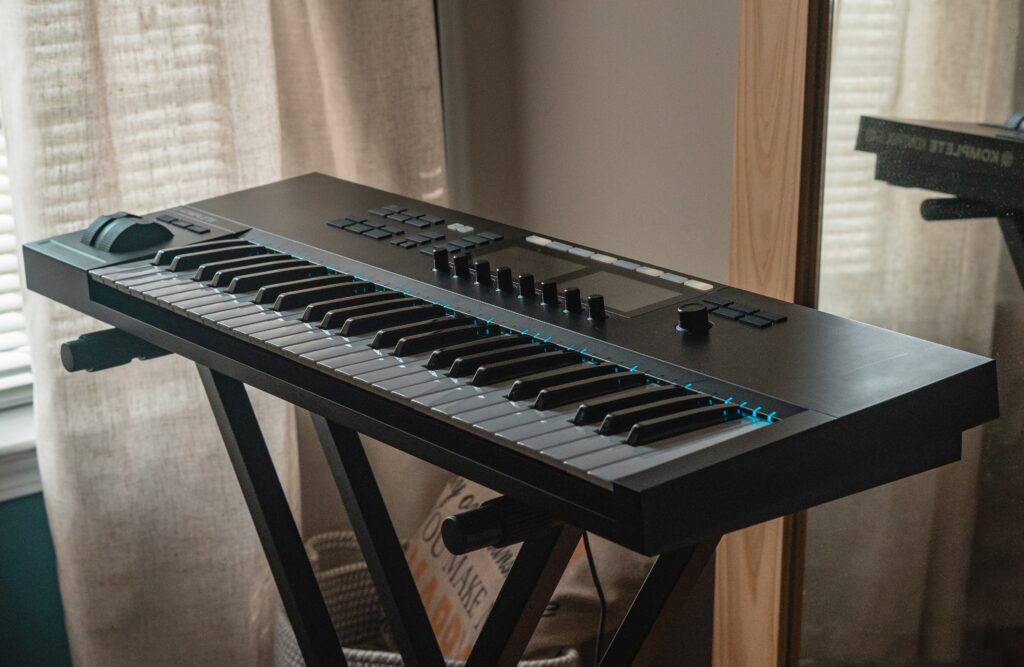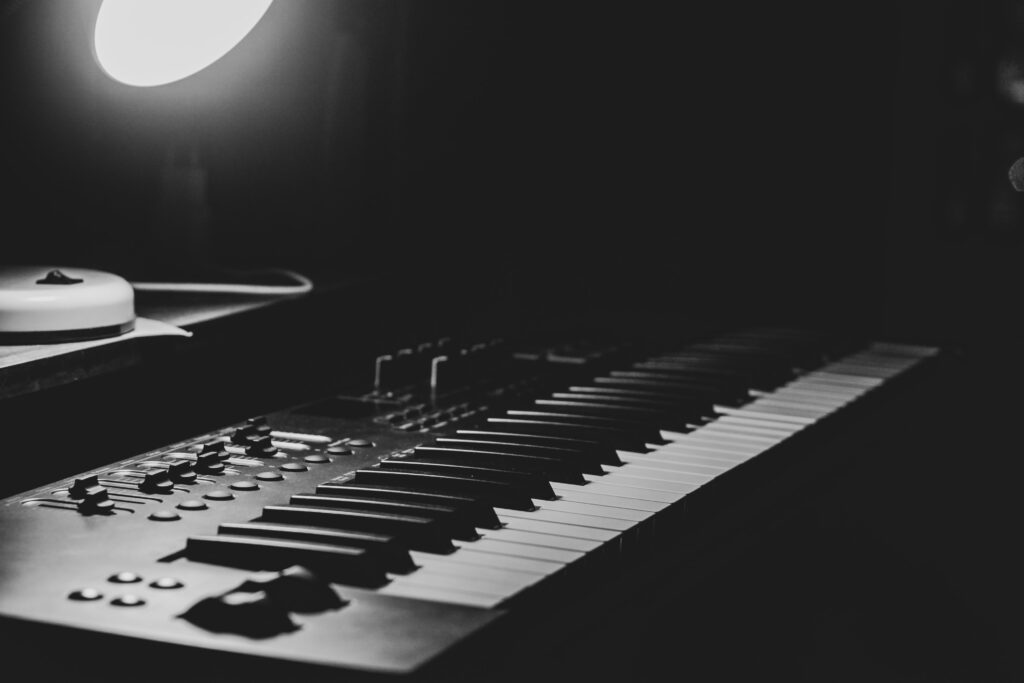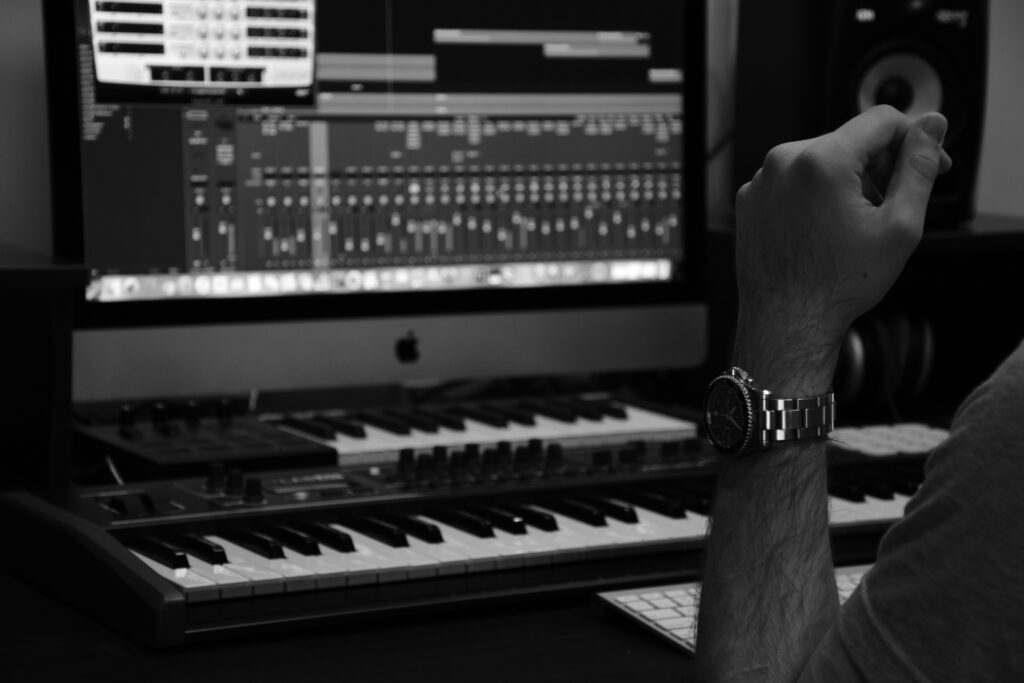49 vs 61 keys is a common debate in the producer community.
Is 49 keys enough? Is 61 keys necessary?
The most popular types of MIDI keyboards fall in these two categories, but which one is right for you?
In this article, we’ll explain the benefits of using a 49-key an a 61-key MIDI keyboard – and the drawbacks/limitations of each.
Here’s everything you need to know.
49 vs 61 Keys: What’s the Difference?

The 49-key MIDI keyboard is the most popular type of MIDI keyboard.
It’s small and portable, making it perfect for traveling musicians or producers who don’t have a lot of studio space.
The 49-key keyboard also has a lower price tag than the 61-key keyboard, making it a great option for beginner producers.
The obvious difference between the 49 and 61-key MIDI keyboard is the number of keys; one has 49 and the other 61 – typically fully size.
The extra keys on the 61-key keyboard provide more range for playing more complex melodies and chords making it better option if you have piano playing experience.
However, a 49-key MIDI keyboard may be all you need if you’re just starting out.
Drawbacks/Limitations of 49-Key MIDI Keyboards
One drawback of 49-key MIDI keyboards is that they have a limited range.
49 keys only span four octaves – unlike the usual seven on a piano – which may not be enough for some compositions.
25 and 49 key MIDI keyboards are great for piecing together complex melodies and chords, but they won’t provide the most fluid playing experience.
They’re also not the best for live performances.
Overall, a 49-key model may not be enough for advanced producers.
Benefit of 61-Key MIDI Keyboards
61 key MIDI keyboards have five octaves, giving you more notes to work with.
This additional octave gives you much more flexibility when playing complex melodies.
Drawbacks/Limitations of 61-Key MIDI Keyboards
One of the drawbacks of 61-key MIDI keyboards is that they’re more expensive than 49-key keyboards.
If you’re just starting out, the 49-key keyboard may be a better option.
61-key models are also larger and heavier than 49-key keyboards, making them less portable.
So, which One Should you Get? 49 vs 61 Keys

We always recommend 49-key keyboards for producers who have no experience playing piano.
They’re generally more affordable, use less space, and 61-keys isn’t necessary unless you’re playing complex melodies.
On the other hand, if you’re an experienced piano player, a 61-key MIDI keyboard is a better option.
[Check out out list of the best 61-key MIDI keyboards here]
49-Key: Pros
- Small and portable
- Lower price tag
49-Key: Cons
- Limited range
- Can be difficult to play with two hands
61-Key: Pros
- Wider range
- Easier to play with two hands
61 Key: Cons
- More expensive than 49-key keyboards
FAQ
What is a MIDI Keyboard?
MIDI keyboards are one of the most popular forms of MIDI controllers used by producers, DJs, and musicians.
They come in the form of piano keyboards but transmit MIDI signals rather than sound.
They offer a wide range of capabilities, making them perfect for both live and studio use.
What is MIDI?
MIDI stands for Musical Instrument Digital Interface, which is a protocol/language that allows (digital/hardware) electronic musical instruments – to communicate with each other.
What Do MIDI Keyboards Do?
MIDI keyboards send MIDI signals to a computer or other device, which can be used to control synthesizers, samplers, and other music software.
What are the Different Types of MIDI Keyboards?
MIDI keyboards come in all shapes and sizes, from compact 25-key models to full-sized 88-key controllers.
There are also many different features available on MIDI keyboards, such as pitch and mod wheels, aftertouch, velocity sensitivity and more.
How Do I Figure Out Which MIDI Keyboard to Buy?
With so many different uses, MIDI keyboards are a must-have for any serious musician or producer.
If you’re looking to buy a MIDI keyboard, it’s important to first consider your needs.
Factors to Consider
Do you need a compact model for traveling? Or do you need a full-sized controller with all the bells and whistles?
When it comes to features, the sky is the limit with high-end MIDI keyboards.
You can get keyboard controllers with all sorts of bells and whistles, from built-in displays and arpeggiators to aftertouch-enabled keys and pitch/mod wheels.
Of course, all that extra stuff comes at a price – often a very steep one.
But if you’re serious about making music with a MIDI keyboard, it’s worth considering investing in one of these higher-end models.
So, what are some of the best features to look for in a high-end MIDI keyboard?
Here are a few of our favorites:
Built-in Displays
A lot of high-end MIDI keyboards come with built-in displays that show you information about the currently selected patch, the status of the controller, and more.
This can be a great way to keep track of what’s going on without having to look at your computer screen all the time.
Aftertouch-Enabled Keys
Aftertouch is a pressure-sensitive feature that allows you to add expressive nuances to your playing. It’s not essential, but it’s a nice bonus if your keyboard has it.
[Here’s a list of the best aftertouch MIDI keyboards]
Pitch/Mod Wheels
These are two essential performance controls that every MIDI keyboard should have.
The pitch wheel allows you to bend notes up or down, while the mod wheel can be used to control things like vibrato, filter cutoff, and more.
Arpeggiator
An arpeggiator is a tool that automatically generates sequences of notes based on the chords you play. If you’re into making electronic music, this is a feature worth looking for.
These are just a few of the many features that you’ll find on high-end MIDI keyboards.
Of course, which ones are most important to you will depend on your specific needs and preferences. But if you’re looking for the best of the best, these are some features to keep an eye out for.
49 vs 61 Keys: Our Recommendation
Why 49 Keys is Better for Beginners

As a beginner, you may not need all the keys on a 49-key MIDI keyboard. But as you progress, you’ll find that having the extra keys gives you more flexibility and creativity.
If you’re starting out, it can be helpful to have a limited number of keys to work with.
This way, you can focus on creating simple melodies without getting overwhelmed by too many options.
As you get better at playing and composing, you’ll find that having more keys gives you more freedom to be creative.
Why 61 Keys is Better for Advanced Producers
You can use a 61-key MIDI keyboard for a variety of tasks in music production – from playing and recording melodies to controlling virtual instruments and plugins.
With so many keys at your disposal, you can create complex chord progressions and melodies that would be difficult to play on a smaller keyboard.
Additionally, most 61-key keyboards come with a variety of assignable buttons and knobs, which can be used to control parameters in your DAW or virtual instruments.
Takeaway: Should I get a 49-key or 61-key MIDI keyboard?
The answer to this question depends on a few factors.
First, consider what you’ll be using the keyboard for.
If you plan on doing a lot of live performances, then a 61-key keyboard may be a better option for you. It provides more range and flexibility when playing.
On the other hand, if you’re mostly going to be using the keyboard for recording in the studio, then a 49-key keyboard may be all you need. This is because most songs don’t require a huge range of notes and you can always add more keys later if needed.
Another factor to consider is price.
61-key keyboards tend to be more expensive than 49-key keyboards, so if budget is a concern, then the 49-key keyboard may be the way to go.
Ultimately, the decision of which keyboard to get is up to you and what you plan on using it for.
Hopefully, this comparison will help you make the best choice.








